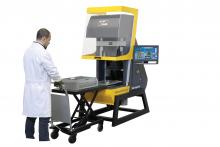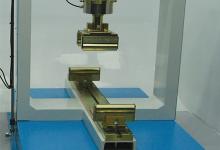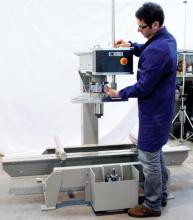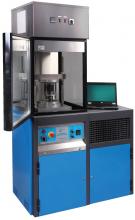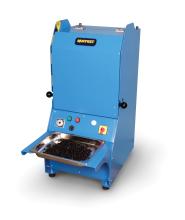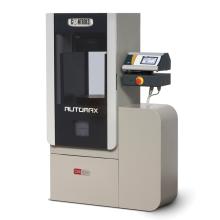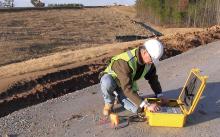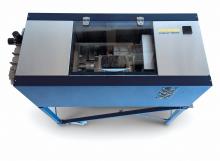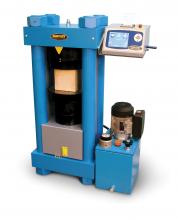This month we look at two new methods which are allowing concrete to be tested on the spot, and [over the page] we catch up on the latest news from concrete testing equipment suppliers - Kristina Smith writes
Sometimes test results can be very bad news. If the concrete pavement or bridge abutment has already been poured, and if the concrete does not meet the specification, the outcome could be very expensive remedial work.
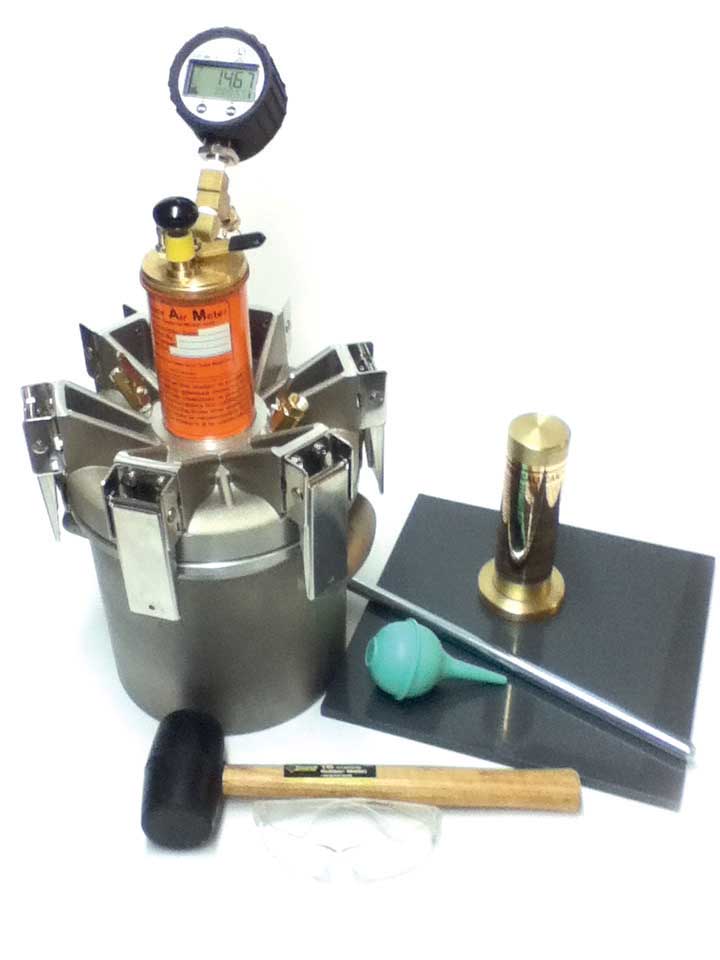
The SAM method is used in 20 states in the US, with Humboldt having developed technology for this application
This month we look at two new methods that are allowing concrete to be tested on the spot, and we catch up on the latest news from concrete testing equipment suppliers - writes Kristina Smith
Sometimes test results can be very bad news. If the concrete pavement or bridge abutment has already been poured, and if the concrete does not meet the specification, the outcome could be very expensive remedial work.
Two recent developments, one concerning air voids in concrete, the other looking at strength gain in structural concrete, give contractors and suppliers more immediate results and the chance to rectify problems or fine tune mixes:2884 Humboldt’s Super Air Meter (SAM) and 203 Doka’s Concremote.
If concrete is to be exposed to freeze-thaw cycles – where water gets into a material, freezes and expands – then the presence of air voids is very important. Freeze-thaw damage is worse when concrete is saturated; by adding air voids, with the help of an air entraining admixture, the possibility of damage can be lessened. As well as the total air content of a concrete, the spacing of voids is important as it has been shown to impact significantly on freeze-thaw durability.
The most common way of measuring the quality of an air void system is ASTM C457, which involves cutting and polishing hardened concrete and inspecting it with a microscope. The downsides to this method are that it takes weeks to obtain results and requires specialist equipment. The SAM method can be used before the concrete has hardened and allows the contractor or concrete supplier to make adjustments to the mix or handling regime if required.
The device and sample preparation for the SAM test method are similar to the AASHTO T 152 (ASTM C231) pressure meter. The SAM test method measures the deformation of the concrete at three pressures, releases the pressure and then repeats the pressure steps and measurements.
The new test provides both the air content as determined by AASHTO T 152 (ASTM C231) and a new measurement called the SAM number, determined from the differences in the two sets of pressure readings, that correlates with the void spacing or the spacing factor. A SAM number of 0.20 has been shown to correctly determine for more than 90% of the time whether the spacing factor is above or below the limit based on the laboratory and field testing.
The SAM test method is currently being used in 20 different states in the US and an AASHTO provisional test method is expected in 2015.
Linked to the same issue, the1229 Iowa Department of Transportation has released a report that looks at the stability of air voids in concrete mixtures containing a range of air-entraining admixture and water-reducing admixture combinations. The total air content of a mixture is normally measured before concrete is placed and consolidated, a practice that is only valid if the air voids are stable.
Recent changes to the chemistry of admixtures have resulted in changes to the concrete during handling, altering the air content and potentially impacting on the concrete’s freeze-thaw resistance and strength. The original aim of the report was to correlate results from the Foam Drainage Test in the laboratory with field results, although this proved difficult as contractors were reluctant to allow testing.
‘Evaluation of Foam Drainage Test to Measure Air Void Stability in Concrete’, written by the National Concrete Pavement Technology Center at Iowa State University of Science and Technology, was published in March 2015.
Usually construction companies rely on manual testing regimes, such as concrete cube strength tests, and would always err on the side of caution before striking formwork. This technology has the ability to reduce the cost of testing and to make the whole process more efficient.
Concremote measures heat development that can then be converted into concrete strength values, using the weighted maturity method. The system has two types of sensors: cable sensors that are incorporated into the wall of the formwork and slab sensors that are inserted into the fresh concrete once it has been screeded.
Wireless transmission of heat measurements, taken at intervals, begins automatically. Results can be accessed on a secure web portal, and e-mail or text message alerts can be set up to inform that early strength has been reached.
Concremote can also help avoid cracks and future structural damage, said Doka. Heat development measurements allow stresses, which result from temperature variations between different parts of the concrete pour, to be monitored.
Concremote has already won two prizes in the Middle East: ‘Best Innovative Formwork Systems’ at the 2014 construction sector summit in Muscat, Oman and the ‘AHK Innovation Award’, from the German-Emirati Chamber of Industry and Commerce in Dubai in February 2015. In its home country, the system is a finalist in the Austrian State Prize for Multimedia and e-Business 2015.
2139 CONTROLS has updated its AUTOMAX E-Modulus for concrete and cement automatic compression, flexural and splitting tests, designed to determine Elastic Modulus and Poisson's Ratio. The machine can automatically carry out compression, flexural and splitting tests on concrete and cement when connected to a suitable testing frame.
The console consists of an ergonomic cabinet that houses the hydraulic system, the electronic boards and the all-in-one PC. PC and software ensure the remote control of the complete system (frame and console) for automatic E-Modulus test execution together with measurement and management of the results.
The console is supplied also with DATAMANAGER software for compression, flexure and splitting tests execution to EN and ASTM.
Cooper Technology’s range of materials testing equipment includes 350 concrete testing machines and accessories, among which are three new products or ranges: a new fully automated cube testing machine, a gyratory compactor and a range of compression and flexural testing machines. The new fully automated machine for testing concrete cubes, the Cooper, has been developed jointly with UK materials supplier 7406 Lafarge Tarmac, bringing together all the individual processes required for concrete cube testing into one machine.
“We’ve automated the process completely so that the machine weighs the cube, centres it, takes all the measurements, recognises which specimen it is through the barcode reader, and finally crushes it,” said Cooper's managing director Peter Grafton. “There’s no chance of the operator making any errors and its footprint is no larger than that of a normal concrete testing machine.”
The Cooper is powered by a CFP Hydraulics hydraulic unit with a Baldor DC motor drive. An Interface Force cantilever load cell weighs the specimen before the test, while a three-axis Hepco Motion linear drives allows the cube to be positioned precisely while measuring its physical dimensions. An Omega pressure transducer measures load during the test.
The Cooper’s heavy-duty steel frame incorporates a specially constructed Denley Hydraulics actuator with integrated rapid jog technology that allows fast pre-test positioning so that spacer pieces are not needed. Sample details and all the test data are compiled via a Cooper Touch+ HMI interface with B&R PLC control.
Having manufactured gyratory compactors for asphalt testing for many years, Cooper has developed a new gyratory compactor for testing non-Portland cement concrete, which it said is the only one used in this field of research. The gyratory compactor’s ability to adjust and control the vertical pressure precisely from low values of 50-60kPa, allows a wide range of concrete workabilities to be tested.
Cooper’s new range of compression and flexural testing machines use the firm’s newly developed Advanced Testing Systems (ATS) control features. The range has been designed with cost in mind, aimed at emerging markets.
The software is capable of running the machine in load control, displacement or strain control mode and automatically calculates elasticity modulus, Poisson’s ratio, yield value and energy. Test speed or mode can be changed by user-friendly buttons during the test and the type of graph or test rate can be changed on the fly.
282 MATEST elastic modulus system for its new cutting-edge laboratory.
“More and more important universities, laboratories and companies around the world are using MATEST elastic modulus systems for tests which meet international standards,” according to Alessandro Peretti, MATEST’s product manager for concrete and cementitious materials.
MATEST’s elastic modulus equipment can be used with a MATEST high-stability frame with a capacity of 2000, 3000, 4000 or 5000kN coupled to the Servo-Plus Evolution automatic servo-controlled system housed in a separate pyramidal frame. VŠCHT’s machine is connected to a 3000kN high-stability press and a high-end combined compression and flexural cement machine, and is one of the first to sport MATEST’s new design.
MATEST’s equipment is being used to carry out tests across a wide number of standards, including Germany’s DIN 1048 standard, UNI EN 12390-13, ISO 1920-10:2010, UNI 6556, ASTM C469, Swiss standard SIA 262-1, Brazilian standard ABNT NBR 8522 and others. It can also test the modulus of elasticity of mortar (UNI EN 13412), rocks (ASTM D7012, UNI 9724-8, ISRM UNE 22950-3) and proppants, used in hydraulic fracturing and gravel-packing operations (ISO 13503-2).
Other laboratories that have purchased elastic modulus systems from MATEST include University Hill in Australia, accredited laboratory Teede Tehnokeskus in Estonia and the Hansa-Nord-Labor laboratory in Hamburg. Hansa-Nord-Labor’s system has been used to test concrete from Hamburg's and Frankfurt’s airports, the military airport in Wunstorf and the bridge Störbrücke along A23 Motorway in Itzehoe, Germany.
1417 Tecnotest has developed a new generation of multifunctional display units for its range of materials testing machines: Touchtronic, Plustronic and Soiltronic.
Touchtronic comes with a standard four channels that can be expanded to eight, with a 255mm touchscreen PC and Windows operating system. It can be used for managing more than one test frame so that the user can perform a range of tests on different specimens and the channels can be used with any type of transducer.
Plustronic comes with two channels and a 125mm touchscreen. Its functions include routines for compression tests, flexural tests, tensile tests and tests using load and displacement control. Seven different language options are also available: Italian, English, French, Spanish, Portuguese, Russian and Polish.
Soiltronic is similar to Plustronic but is only for Tecnotest’s soil-testing machines.
Sometimes test results can be very bad news. If the concrete pavement or bridge abutment has already been poured, and if the concrete does not meet the specification, the outcome could be very expensive remedial work.
Two recent developments, one concerning air voids in concrete, the other looking at strength gain in structural concrete, give contractors and suppliers more immediate results and the chance to rectify problems or fine tune mixes:
Humboldt
Researchers at Oklahoma State University–Stillwater have developed a new device that measures both the air void spacing and air content of fresh concrete in about 10 minutes. It is called the Super Air Meter (SAM) and it is now available from Humboldt Manufacturing Company.If concrete is to be exposed to freeze-thaw cycles – where water gets into a material, freezes and expands – then the presence of air voids is very important. Freeze-thaw damage is worse when concrete is saturated; by adding air voids, with the help of an air entraining admixture, the possibility of damage can be lessened. As well as the total air content of a concrete, the spacing of voids is important as it has been shown to impact significantly on freeze-thaw durability.
The most common way of measuring the quality of an air void system is ASTM C457, which involves cutting and polishing hardened concrete and inspecting it with a microscope. The downsides to this method are that it takes weeks to obtain results and requires specialist equipment. The SAM method can be used before the concrete has hardened and allows the contractor or concrete supplier to make adjustments to the mix or handling regime if required.
The device and sample preparation for the SAM test method are similar to the AASHTO T 152 (ASTM C231) pressure meter. The SAM test method measures the deformation of the concrete at three pressures, releases the pressure and then repeats the pressure steps and measurements.
The new test provides both the air content as determined by AASHTO T 152 (ASTM C231) and a new measurement called the SAM number, determined from the differences in the two sets of pressure readings, that correlates with the void spacing or the spacing factor. A SAM number of 0.20 has been shown to correctly determine for more than 90% of the time whether the spacing factor is above or below the limit based on the laboratory and field testing.
The SAM test method is currently being used in 20 different states in the US and an AASHTO provisional test method is expected in 2015.
Linked to the same issue, the
Recent changes to the chemistry of admixtures have resulted in changes to the concrete during handling, altering the air content and potentially impacting on the concrete’s freeze-thaw resistance and strength. The original aim of the report was to correlate results from the Foam Drainage Test in the laboratory with field results, although this proved difficult as contractors were reluctant to allow testing.
‘Evaluation of Foam Drainage Test to Measure Air Void Stability in Concrete’, written by the National Concrete Pavement Technology Center at Iowa State University of Science and Technology, was published in March 2015.
Doka
Delivering real-time monitoring of concrete, formwork specialist Doka has developed a system that measures the strength development of concrete using sensors connected wirelessly to a computer. Concremote has the potential to speed up the construction process, as the point at which formwork is stripped depends on the concrete reaching the right compressive strengths.Usually construction companies rely on manual testing regimes, such as concrete cube strength tests, and would always err on the side of caution before striking formwork. This technology has the ability to reduce the cost of testing and to make the whole process more efficient.
Concremote measures heat development that can then be converted into concrete strength values, using the weighted maturity method. The system has two types of sensors: cable sensors that are incorporated into the wall of the formwork and slab sensors that are inserted into the fresh concrete once it has been screeded.
Wireless transmission of heat measurements, taken at intervals, begins automatically. Results can be accessed on a secure web portal, and e-mail or text message alerts can be set up to inform that early strength has been reached.
Concremote can also help avoid cracks and future structural damage, said Doka. Heat development measurements allow stresses, which result from temperature variations between different parts of the concrete pour, to be monitored.
Concremote has already won two prizes in the Middle East: ‘Best Innovative Formwork Systems’ at the 2014 construction sector summit in Muscat, Oman and the ‘AHK Innovation Award’, from the German-Emirati Chamber of Industry and Commerce in Dubai in February 2015. In its home country, the system is a finalist in the Austrian State Prize for Multimedia and e-Business 2015.
CONTROLS
The console consists of an ergonomic cabinet that houses the hydraulic system, the electronic boards and the all-in-one PC. PC and software ensure the remote control of the complete system (frame and console) for automatic E-Modulus test execution together with measurement and management of the results.
The console is supplied also with DATAMANAGER software for compression, flexure and splitting tests execution to EN and ASTM.
5941 Cooper Technology
Cooper Technology’s range of materials testing equipment includes 350 concrete testing machines and accessories, among which are three new products or ranges: a new fully automated cube testing machine, a gyratory compactor and a range of compression and flexural testing machines. The new fully automated machine for testing concrete cubes, the Cooper, has been developed jointly with UK materials supplier “We’ve automated the process completely so that the machine weighs the cube, centres it, takes all the measurements, recognises which specimen it is through the barcode reader, and finally crushes it,” said Cooper's managing director Peter Grafton. “There’s no chance of the operator making any errors and its footprint is no larger than that of a normal concrete testing machine.”
The Cooper is powered by a CFP Hydraulics hydraulic unit with a Baldor DC motor drive. An Interface Force cantilever load cell weighs the specimen before the test, while a three-axis Hepco Motion linear drives allows the cube to be positioned precisely while measuring its physical dimensions. An Omega pressure transducer measures load during the test.
The Cooper’s heavy-duty steel frame incorporates a specially constructed Denley Hydraulics actuator with integrated rapid jog technology that allows fast pre-test positioning so that spacer pieces are not needed. Sample details and all the test data are compiled via a Cooper Touch+ HMI interface with B&R PLC control.
Having manufactured gyratory compactors for asphalt testing for many years, Cooper has developed a new gyratory compactor for testing non-Portland cement concrete, which it said is the only one used in this field of research. The gyratory compactor’s ability to adjust and control the vertical pressure precisely from low values of 50-60kPa, allows a wide range of concrete workabilities to be tested.
Cooper’s new range of compression and flexural testing machines use the firm’s newly developed Advanced Testing Systems (ATS) control features. The range has been designed with cost in mind, aimed at emerging markets.
The software is capable of running the machine in load control, displacement or strain control mode and automatically calculates elasticity modulus, Poisson’s ratio, yield value and energy. Test speed or mode can be changed by user-friendly buttons during the test and the type of graph or test rate can be changed on the fly.
MATEST
VŠCHT, the University of Chemistry and Technology, Prague, is the latest institution to purchase a“More and more important universities, laboratories and companies around the world are using MATEST elastic modulus systems for tests which meet international standards,” according to Alessandro Peretti, MATEST’s product manager for concrete and cementitious materials.
MATEST’s elastic modulus equipment can be used with a MATEST high-stability frame with a capacity of 2000, 3000, 4000 or 5000kN coupled to the Servo-Plus Evolution automatic servo-controlled system housed in a separate pyramidal frame. VŠCHT’s machine is connected to a 3000kN high-stability press and a high-end combined compression and flexural cement machine, and is one of the first to sport MATEST’s new design.
MATEST’s equipment is being used to carry out tests across a wide number of standards, including Germany’s DIN 1048 standard, UNI EN 12390-13, ISO 1920-10:2010, UNI 6556, ASTM C469, Swiss standard SIA 262-1, Brazilian standard ABNT NBR 8522 and others. It can also test the modulus of elasticity of mortar (UNI EN 13412), rocks (ASTM D7012, UNI 9724-8, ISRM UNE 22950-3) and proppants, used in hydraulic fracturing and gravel-packing operations (ISO 13503-2).
Other laboratories that have purchased elastic modulus systems from MATEST include University Hill in Australia, accredited laboratory Teede Tehnokeskus in Estonia and the Hansa-Nord-Labor laboratory in Hamburg. Hansa-Nord-Labor’s system has been used to test concrete from Hamburg's and Frankfurt’s airports, the military airport in Wunstorf and the bridge Störbrücke along A23 Motorway in Itzehoe, Germany.
Tecnotest
Touchtronic comes with a standard four channels that can be expanded to eight, with a 255mm touchscreen PC and Windows operating system. It can be used for managing more than one test frame so that the user can perform a range of tests on different specimens and the channels can be used with any type of transducer.
Plustronic comes with two channels and a 125mm touchscreen. Its functions include routines for compression tests, flexural tests, tensile tests and tests using load and displacement control. Seven different language options are also available: Italian, English, French, Spanish, Portuguese, Russian and Polish.
Soiltronic is similar to Plustronic but is only for Tecnotest’s soil-testing machines.

